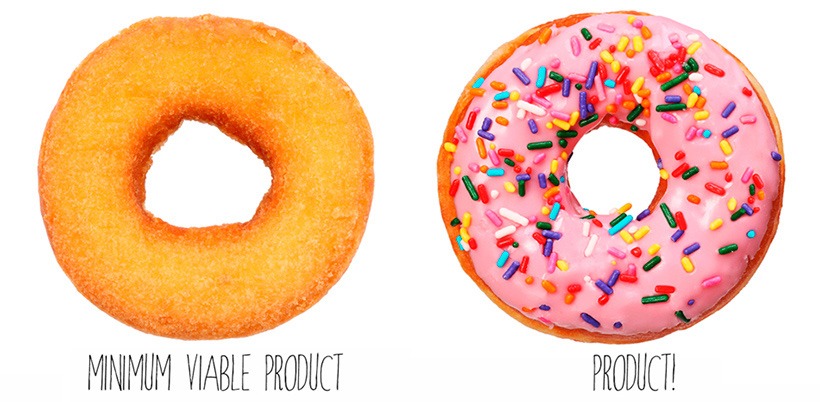Building a Minimum Viable Product in the right way will ensure a good beginning for your startup business and help to avoid the failure.
Every day mushrooming startups try to bring their market-changing ideas to life by developing products, apps, or websites either on their own or with the help of professional teams. Through pain and gain some of them become successful, and after spending weeks or months on development, their ideas finally make a breakthrough on the market while the other 90% fail. Why then?

The research shows that the most typical mistake of startups is the lack of interest in what they offer. Almost half of all failures have been due to no actual market need.
No matter if it's VR app development, the creation of a cross-platform mobile application or cloud application development, bringing a new product to the masses is always risky, and you have to be quick and smart about it to succeed. Building a Minimum Viable Product in the right way will ensure a good beginning for your startup business and help to avoid the failure.
To start with, let’s define what an MVP actually is. Is it an end product? Or a beta version with sophisticated features and impressive design? Or maybe it is a product version you can start earning a profit with? Well, none of the above.
MVP is not about impressing someone with the design or a full set of features. It is not about earning a profit—ot at this stage. A minimum viable product is a process of building your perfect solution that can solve a certain need/problem for end users. It is a mix of minimalism and functionality: an experiment that can lead to success, often through trial and error.
What we love about building an MVP is that it gives an opportunity to test the waters, learn the market needs, and gather feedback from end users before starting to invest in the development of a full product. There is no better way to determine the feasibility of your ideas than building a minimum viable product.
With this article, let’s find out the 7 most typical mistakes startups make when developing their MVPs.
Ignoring the Marketing Research

As mentioned above, not knowing the market is one of the main reasons for all failures. Almost half of startups fail because their product ideas are not new and there is already a bunch of similar services on the market. Ignoring the marketing research can come at a cost, and after wasting your money on building an MVP, you may find out that your business idea is either not validated or there are a lot of similar offers and yours doesn’t have any competitive advantage. A reliable tech partner can help at this stage by conducting complex marketing research before developing an MVP to validate the potential of your business idea.
Not the Right Development Team

Another reason why startups fail with their ideas is an inexperienced and unprofessional team. It is hardly possible to build a good MVP with a team that either lacks technical skills or has never developed an MVP before.
Even if a specification is clear and does not include a lot of features, we still recommend working with a professional team of designers, developers, QA engineers, and PMs to be able to quickly and effectively adjust to the changing requirements and deliver a proper product.
Here is what can happen when trusting your MVP to an unprofessional team:
- Missed deadline. Since MVPs are needed for new hot ideas to test the assumptions and find a certain amount of support among end users, they should be developed really fast and delivered to early adopters as soon as possible. A team that has never developed an MVP before will definitely miss tight deadlines and spoil it all. Timing is everything.
- Feedback interpretation issues. Once an MVP is out and you receive the first feedback from users, you need to adjust the product rapidly or even change the entire strategy. A less experienced team will most likely face problems with the interpretation of feedback to make proper corrections and deliver the next product version.
Commitment to Excellence

Perfectionism is good, but sometimes striving for perfection comes at a cost. The main purpose of an MVP is to test the idea before moving to full production. A good MVP has only a few core functions that give end users an understanding of your product and what problems it solves. There is no need to polish the design or add more and more features to impress the audience. It may happen that after spending the largest part of a project budget on building “a perfect MVP,” the product idea will be rejected by people. It's like throwing money out the window.
Some clients, on the contrary, strive for minimalism, forgetting that it should be not only a minimum but also a viable product. Reducing a set of features, they forget about what makes their product unique and useful for users.
Selection of features is an essential process in MVP development. An experienced technology partner can help at this point and compile a feature list based on their experience and/or market research they can do for you.
Wrong Way of Building an MVP
Many startup businesses think that it is not possible to develop a minimum product that is also viable, and they keep users unhappy until release number 126. They are making one and the same mistake releasing MVP versions that turn the customers off due to the lack of usefulness and viability. This is what it looks like:
The right way of building an MVP is called a “cupcake method.” Despite the simplicity of the first product versions, they all should solve the needs/problems of customers and help to complete their goals. Thus, clients stay happy with the results while the development team keeps on extending the functionality and improving the design.
It is important that every release of your product should be a better solution with new perks for users.
No Prototyping Phase
Another important phase in building your perfect MVP is prototyping. Many startups skip this phase to enter the development phase as soon as possible, but they shouldn’t do this. It allows one to solve many problems and make the app development process much smoother. Moreover, if you think about introducing your ideas to investors, there is no better thing than a visual presentation of ideas with the help of interactive prototypes. This will help you make things clearer to all team members and bring your project idea to life with minimum losses.
- You should start with an interface architecture and build a basic structure of your product and some general information about it. It can be formalized shortly through a technical specification or other supporting documentation.
- The next step is about building a rough wireframe with a product architecture and main interactive elements on it. Such wireframes can be even drawn on a piece of paper by hand.
- Sometimes a rough wireframe is not sufficient, and clients ask to build a high-fidelity prototype that presents a product through a graphic image with a number of interactive elements on it. Such a prototype looks more professional and presents the idea in the best possible way.
Prototyping helps not only effectively present your vision to investors, but also ensures a good foundation for the development phase.
Disregarding Analytics and User Feedback

One of the main purposes of an MVP is gathering user feedback about the product idea. Not being attentive to this feedback deprives the whole process of any meaning. To estimate the future success of your product, you should not only thoroughly study the feedback received from early adopters, but also draw appropriate conclusions. Your product is designed for real people who will (or will not) use it daily, so it should be your top priority to gather the feedback, analyze it, and make proper adjustments to keep users satisfied with every part of the solution.
And furthermore, do not forget about implementing analytics into your app or a website to monitor and measure active users as well as check the retention rate and time users spend on the website or mobile app. Striving for perfection is not good, but if you notice that something goes wrong - do not ignore it and be sure to remedy the situation quickly.
Insufficient Scalability
While most startups are mentally prepared for failure, only a few of them are prepared for overnight success. I don’t mean a bottle of champagne secured for the celebration. I mean readiness on the technical side. Just image your product makes a breakthrough on the market and thousands of new users come knocking at your door. Is your product scalable enough to handle the unexpected load?
Many startups do not consider the scalability factor of their MVPs, but it is an essential parameter in case of a success. Not to put your project at a stalemate, you need to be attentive and avoid this common mistake. When building an MVP solution for startup businesses, we always craft a purely scalable product to stay prepared for a sudden increase in the number of users.
Conclusion
What if your product idea is really life-changing and we all are standing on the brink of a technical revolution? You need to be proactive and give it a shot. But before moving into production of your minimum viable product, ask yourself a few questions. What makes your product unique? What problems does it solve? Who are the intended users of your product and why?
Once you are ready to move ahead, find a reliable and experienced software development team to bring your ideas to life. We at Program-Ace know how to define a minimal scope of work, build a reliable and scalable MVP solution, track user activities, gather, and interpret user feedback, and what is more important, quickly react to market changes and make timely adjustments.
If you need more information about how we can help you build a successful minimum viable product, do not hesitate to contact our technical team and ask questions.




















